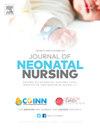新生儿重症监护室高危新生儿的疼痛和疼痛相关压力——一篇叙述性综述
Q2 Nursing
引用次数: 0
摘要
在新生儿重症监护病房暴露于疼痛和压力会显著影响高危新生儿的神经发育,增加发育迟缓的风险。缺乏标准化的疼痛管理政策阻碍了有效的护理。这篇叙述性的综述检查了新生儿疼痛和压力的观察性研究。在PubMed, EMBASE, CINAHL, Scopus, Web of Science, ProQuest和b谷歌Scholar中进行了系统搜索,确定了15项相关研究。研究结果显示,新生儿平均每天接受16次手术,早产儿比足月新生儿经历更痛苦的手术。常见的方法包括脚跟穿刺、抽吸、静脉穿刺、导管插入和胶带移除,其中动脉线插入和插管是最痛苦的。新生儿胎龄、出生体重、新生儿重症监护病房住院时间和医疗条件影响疼痛频率和强度。药物和非药物方法都能有效地减轻疼痛和压力。标准化的疼痛管理策略对于最小化疼痛相关压力及其长期神经发育后果至关重要。本文章由计算机程序翻译,如有差异,请以英文原文为准。
Pain and pain-related stress in high-risk neonates at NICU – A narrative review
Exposure to pain and stress in the NICU significantly impacts the neurodevelopment of high-risk neonates, increasing the risk of developmental delays. The lack of standardized pain management policies hinders effective care. This narrative review examined observational studies on neonatal pain and stress. A systematic search in PubMed, EMBASE, CINAHL, Scopus, Web of Science, ProQuest, and Google Scholar identified 15 relevant studies. Findings revealed that neonates undergo a median of 16 procedures per day, with preterm infants experiencing more painful procedures than term neonates. Common procedures include heel lance, suctioning, venepuncture, catheter insertion, and tape removal, with arterial line insertion and intubation being the most painful. Neonatal gestational age, birth weight, NICU stay, and medical condition influenced pain frequency and intensity. Both pharmacological and nonpharmacological approaches effectively reduced pain and stress. Standardized pain management strategies are crucial to minimizing pain-related stress and its long-term neurodevelopmental consequences.
求助全文
通过发布文献求助,成功后即可免费获取论文全文。
去求助
来源期刊

Journal of Neonatal Nursing
Nursing-Pediatrics
CiteScore
2.00
自引率
0.00%
发文量
143
期刊介绍:
Aims & Scope: This is the practical, bimonthly, research-based journal for all professionals concerned with the care of neonates and their families, both in hospital and the community. It aims to support the development of the essential practice, management, education and health promotion skills required by these professionals. The JNN will provide a forum for the exchange of ideas and information between the range of professionals working in this field; promote cooperation between these professionals; facilitate partnership care with families; provide information and informed opinion; promote innovation and change in the care of neonates and their families; and provide an education resource for this important rapidly developing field.
 求助内容:
求助内容: 应助结果提醒方式:
应助结果提醒方式:


